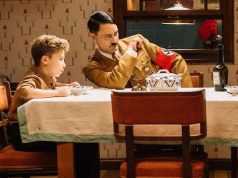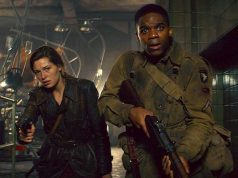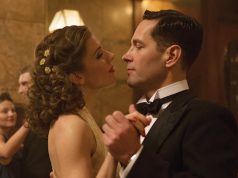Clint Eastwood, at the age of 75, directed two movies this year, both of them shot in difficult locations, both addressing complicated issues, and both populated with large casts, with one of them acting in a foreign language. Making one such film in a year is a noteworthy achievement. Making two is genuinely impressive, and making two at the age of 75 is stunning, maybe even unprecedented. Eastwood deserves some kind of Special Jury Prize just for the effort, regardless of the films’ actual quality.
Which brings up a curious point. “Flags of Our Fathers” is a good movie, but not a great one. “Letters from Iwo Jima,” which gives the Japanese perspective on the World War II battle for that island, is a very, very good movie, though still not one for the ages. Yet taken together, the two films are resonant, refined, and remarkable, offering an intimate view of war and patriotism. They are much greater than the sum of their parts.
“Letters” was written by a Japanese woman, Iris Yamashita, and unfolds, for authenticity’s sake, in the language of the characters (subtitled, of course). It’s set in late 1944 and early 1945 as the Japanese military defends Iwo Jima, a Pacific island that represents Japan’s last stronghold against the Allied forces. The Japanese know it is a lost cause — “These are the holes we will fight in and die in,” says one leader, well aware that death is how it will end for nearly everyone present — and that it would be wiser to ditch the island and be spared the bloodshed. But there is never any question of giving up or disobeying. The mindset of the Japanese military is that when given the option of being killed or retreating, there is no option.
The film parallels the classic Hollywood war movies, using many of the same character types (naive young soldier, fatherly commanding officer, brutal enemies, etc.) and simply reversing the nationalities. Gen. Kuribayashi (Ken Watanabe) is a smart, unorthodox leader who has just arrived at Iwo Jima to help resist the impending American attack. Maj. Gen. Hayashi (Ken Kensei), more hardened and strict (he’s first seen whipping a shirking soldier) thinks Kuribayashi belongs behind a desk, not overseeing a major war skirmish, and he’s baffled by some of the general’s tactics. He’s also suspicious of the fact that Kuribayashi spent time in America in his youth. Could he be a sympathizer?
Kuribayashi soon befriends Baron Nishi (Tsuyoshi Ihara), an Olympic medal-winning equestrian and notorious ladies’ man who is now in charge of the Japanese tanks. The two men have a kinship as outsiders, as patriotic Japanese citizens who don’t quite belong here on Iwo Jima.
In the trenches (and caves and sandpits) is a private named Saigo (Kazunari Ninomiya) whose wife was pregnant when he was drafted and has since given birth to a baby he’s never seen. Saigo is not the stoic, passionless Japanese soldier we usually see in U.S.-centric World War II movies. He is terrified and lonely, occasionally brave but often desperate, motivated by very real human emotions. His friend, Nozaki (Yuki Matsuzaki), is a kindred spirit, occupying his time with being suspicious of the enigmatic new soldier, Shimizu (Ryo Kase), who has just been placed in their platoon. Nozaki thinks Shimizu is a snitch sent by their higher-ups to monitor their work.
Their work, at least at first, includes digging trenches on the beaches and establishing strongholds in the island’s hills and mountains. When the Americans arrive, the Japanese are virtually invisible and able to mow down dozens of Yankees before the latter can even spot them. But the tide turns soon enough, as you know — and as the Japanese are ominously aware of long before the fact — and the imperial forces are soon being killed at an alarming rate.
Eastwood directs the personal scenes with tenderness and the battle scenes with shocking frankness. His cinematographer, Tom Stern (a regular Eastwood collaborator), casts most of the picture in stark, metallic colors, almost black-and-white. Only the flags, explosions, and blood come through vividly. The occasional flashbacks to pre-war times — Saigo with his wife, Kuribayashi visiting America in the 1930s, etc. — are rendered more brightly, too, as befits their wistful tone.
The overall effect is to humanize the enemy. The fact that 60 years have passed and the “enemy” is now a close friend makes the war seem even more absurd, the monstrous casualties more futile. How could we have fought against such decent, ordinary people? How could they fight against us? The best war films are actually anti-war films, of course, condemning the brutality while honoring the courage and sacrifice that come from it. “Letters from Iwo Jima” fits that mold nicely. It has a false move here and there — as with “Flags of Our Fathers,” the present-day framing story feels superfluous — but the overall effect is powerful.
B+ (2 hrs., 21 min.; Japanese with subtitles; )





